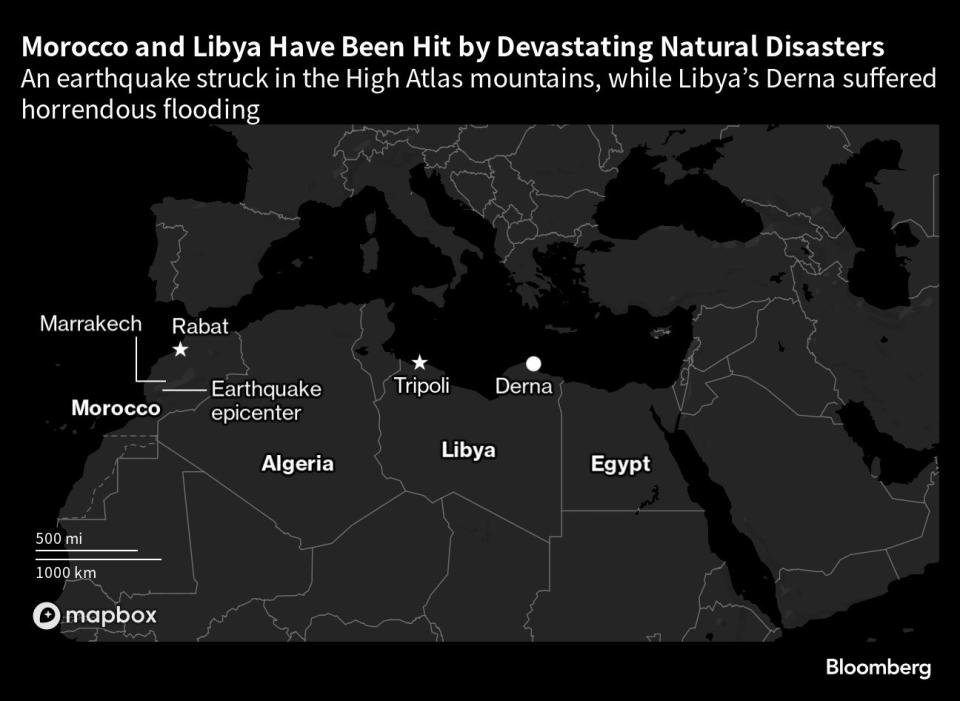Libya, Morocco Death Toll Nears 9,000 as Rescuers Comb Wreckage
- Oops!Something went wrong.Please try again later.
(Bloomberg) -- Rescuers waded in waist deep water in Libya and dug through crumbled mud brick buildings in Morocco in search of survivors after dual natural disasters over the weekend left at least 9,000 people dead.
Most Read from Bloomberg
Video-Game Company Unity Closes Offices Following Death Threat
Disney Holds Initial Talks on Sale of ABC to Local Broadcaster Nexstar
Local relief workers, volunteers and international organizations slogged through mud and water in Derna, a coastal town in the northeast of Libya where torrential rain unleashed by Mediterranean storm Daniel led to the collapse of two dams. Roaring flash floods ripped down the mountainside, with walls of water several meters high demolishing everything in their path.
Officials said at least 5,500 people were dead and another 10,000 missing - a tally that represents about 16% of the city’s population.
Meanwhile, thousands of kilometers west, authorities revised the death toll from the strongest earthquake to hit Morocco in 120 years to 2,946, with another 5,674 people hurt. The temblor that struck in the High Atlas mountains on Sept. 8 demolished buildings and, in some cases, small villages where the dwellings were made of mud brick and adobe.
The two disasters, days apart, created logistical and humanitarian nightmares for the respective governments and cast an unwelcome spotlight on the effect of years, if not decades, of neglect in some regions. Even as foreign nations offer assistance to both nations, internal political sensitivities and tensions threaten to stymie recovery efforts.
Morocco Hasn’t Accepted French Aid - and Macron Isn’t Happy
The villages and towns affected by the Moroccan earthquake sat not far from tourism magnet Marrakech but saw little of the economic inflow that city enjoyed. Morocco’s King Mohammed VI made a rare public appearance and visited some of the affected areas. The display, however, highlighted his prolonged absences from public life and frequent, yet largely unreported, overseas trips.
Other factors came into play in Libya, where oversight of the nation that sits atop Africa’s largest reserves of crude oil is divided between rival governments in the east and west.
Libya’s Derna, known for rugged mountain backdrops and waterfalls, could emerge as a litmus test for what’s gone wrong in the OPEC nation.
An opposition hotspot during the rule of former Libyan leader Moammar Al Qaddafi, Derna morphed into an extremist haven after the dictator’s ouster. While Islamist extremists were crushed by eastern-based strongman Khalifa Haftar late in the last decade, it’s seen little of the investment inflows that Benghazi, 290 kilometers to the west, enjoyed.
Officials in the Tripoli-based government, including Prime Minister Abdul Hamid Dbeibah, have cast the tragedy in Derna and other towns in the east as both a challenge and an opportunity to unite.
“Our injuries are one and our people are one, supporting each other with sacrifice and redemption,” Dbeibah said on X, the platform formerly known as Twitter.
How Global Warming Makes Extreme Weather More Likely: QuickTake
Libya’s neighbors have stepped up, as have several foreign nations. Egypt dispatched a helicopter carrier and converted it into a floating field hospital, Daily News Egypt reported on its website. In all, 12 nations have either provided boots on the ground or logistical, humanitarian and financial aid, the Tripoli-based government said.
But equally significant have been domestic efforts. Aid has been dispatched from cities across Libya. The Libyan Red Crescent said 27 trucks from the western city of Misrata had arrived with relief supplies in al-Bayda, one of the eastern cities affected. It said the move “strengthens national unity” in Libya.
Most Read from Bloomberg Businessweek
How Sam Bankman-Fried’s Elite Parents Enabled His Crypto Empire
Everyone’s Worrying About China, But the Real Pain Is Coming From the Fed
ADHD Drug Shortages Worsen as Makers Say Production Is Maxed Out
©2023 Bloomberg L.P.



